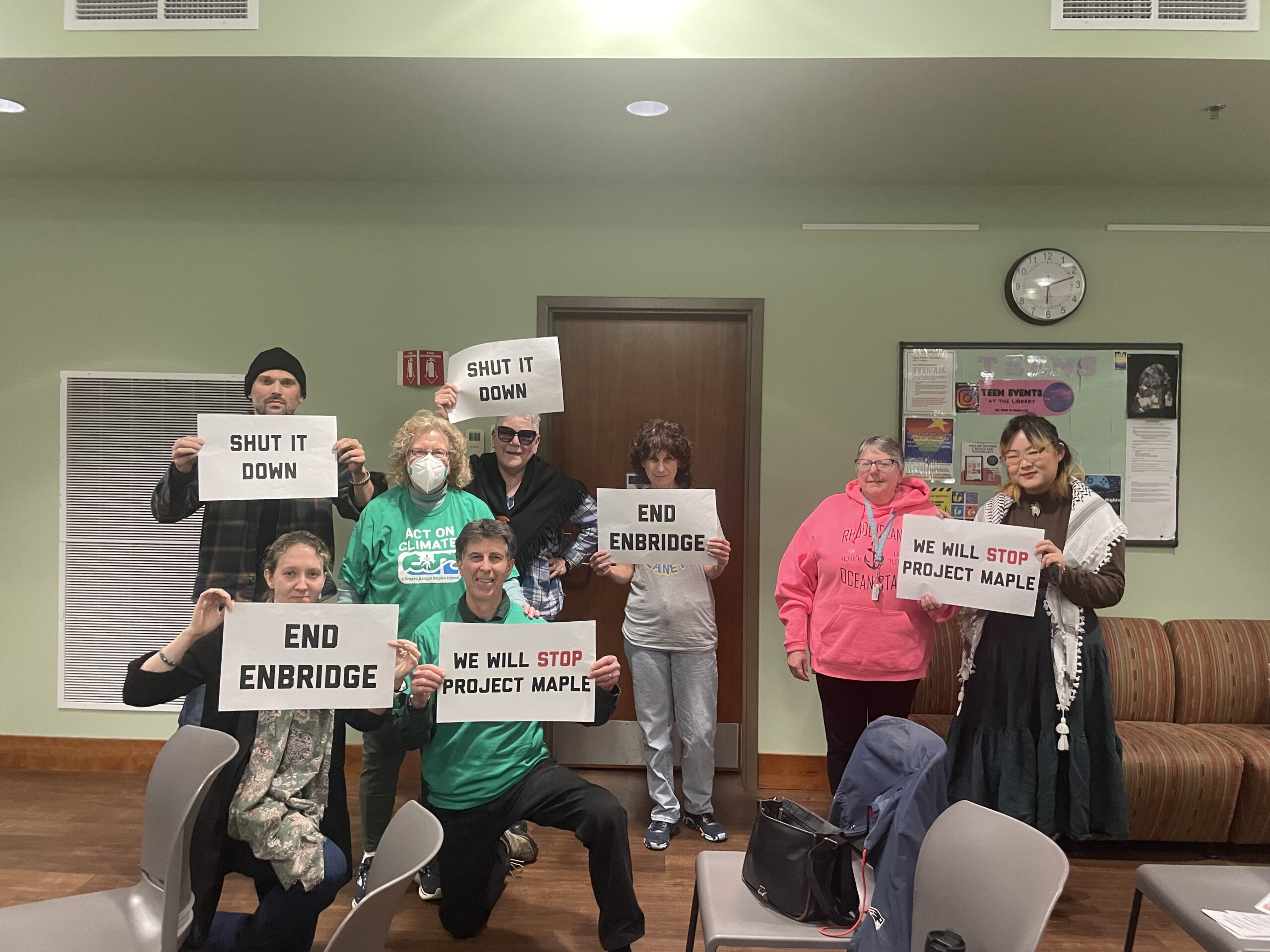Energy Facility Siting Board’s Written Decision Explains Why Proposed Burrillville Power Plant Wasn’t Needed
November 6, 2019
The Energy Facility Siting Board’s much-anticipated written decision regarding the fossil fuel power plant that had been proposed for Burrillville, R.I., elaborates on the reasoning the application for the nearly 1,000-megawatt facility was denied. The report also leaves some issues unanswered.
Back on June 20, the three-person Energy Facility Siting Board (EFSB) made quick work of more than three years of hearings and proceedings by unanimously rejecting the Clear River Energy Center (CREC). The board ruled that the proposed natural gas/diesel facility wasn’t necessary to meet regional electricity demand.
Its decision to deny the CREC, proposed by Chicago-based Invenergy LLC, was based on a broad interpretation of “need” for the facility and its fast-start capability.
Two other criterion required for approval, cost justification and environmental harm, aren’t addressed in the 33-page report, which was released this week. The EFSB didn’t address those issues at its late-June meeting, and leaves them out of its written decision, because, it argued, that failing to satisfy one criteria makes it unnecessary to scrutinize the other two.
“The board need not reach the remaining elements set out in the (Energy Facility Siting) Act in its consideration of the proposed facility’s application,” according to the report signed by EFSB chairwoman Margaret Curran and board members Janet Coit and Meredith Brady.
Although cost justification and environmental impacts were addressed in depth throughout the application review process, Invenergy and project opponents agreed that the questions of need and environmental harm were the central issues in determining the facility’s fate. The question of need, however, was the first debated at the EFSB’s June 20 meeting.
Invenergy positioned the power plant as a modern, lower-polluting, and reliable link from older, higher-polluting facilities to a dynamic, decentralized grid dominated by multiple renewable-energy sources. Company officials said the $1 billion facility would create 350 jobs, lower energy bills, and increase property tax revenue for the rural host community.
The EFSB, however, decided there is ample power now and in the future to meet energy expectations for the state and region, especially as renewable energy proliferates and energy-efficiency programs lessen demand.
The loss of a key power-purchase agreement on Sept. 20, 2018 and the failure to secure future ones through ISO New England, the regional operator of the power grid, hurt the developer’s credibility in the eyes of the EFSB.
The board’s recently released decision offers a summary of the proceedings that began when the docket was filed Nov. 17, 2015 and the course of discussion that led to the unanimous vote in June. It also recounts Invenergy’s struggle to secure a source for cooling water, its failure to obtain a power-purchase agreement for one of the facility’s power units, and other setbacks that delayed the hearing process.
Although Invenergy blamed the stoppages on public opposition and the EFSB itself, the written decision puts the fault squarely on Invenergy.
“It is worth noting that the majority of the delays were caused by the applicant,” according to the EFSB’s decision. “The board does not suggest that Invenergy did anything wrong in causing the delays. However, the board does want to make clear that Invenergy cannot place blame for the delays, or the consequence they wrought, on the board.”
The written decision elaborates on other details, such as the reasoning for dismissing Invenergy’s argument that the power plant was consistent with Rhode Island’s long-term energy plan.
“Adding a new natural gas plant — even a fast-start, more efficient one — does not advance the stated goals of greater fuel diversity, significantly lowered greenhouse gas emissions, or a transformed system,” according to the decision. “Adding Invenergy’s proposed facility would, at most, perpetuate the status quo.”
The EFSB’s written decision also noted that an advisory opinion offered by the Division of Statewide Planning didn’t satisfy the issue of need, even though the report by the state agency said the project is consistent with the state energy plan.
With the release of the EFSB’s written decision, the CREC application is officially nullified. Invenergy must file an entirely new application to restart the project, a process that would likely take years to advance.
Invenergy has 10 days to appeal the decision in Rhode Island Supreme Court.
“Invenergy is reviewing the EFSB’s written order and determining next steps,” Invenergy spokeswoman Beth Conley said.
Pending permits from the Army Corps of Engineers and the Rhode Island Department of Environmental Management were paused when the EFSB denied the application.
One of the primary objectors to CREC, the Conservation Law Foundation, promised to litigate against Invenergy if a court appeal is filed.
Categories
Join the Discussion
View CommentsRecent Comments
Leave a Reply
Related Stories
Your support keeps our reporters on the environmental beat.
Reader support is at the core of our nonprofit news model. Together, we can keep the environment in the headlines.
We use cookies to improve your experience and deliver personalized content. View Cookie Settings




“Two other criteria required for approval, cost justification and environmental harm, aren’t addressed in the 33-page report, which was released this week. The EFSB didn’t address those issues at its late-June meeting, and leaves them out of its written decision, because, it argued, that failing to satisfy one criteria makes it unnecessary to scrutinize the other two.”
Unnecessary. So, we will never know what the three EFSB members understood about “environmental harm”, or to be specific, how they would have interpreted the wording of the Energy Facility Siting Act, “…. the facility shall produce the fewest possible adverse effects on the quality of the state’s environment; most particularly, its land and its wildlife and resources, the health and safety of its citizens, the purity of its air and water, its aquatic and marine life, and its esthetic and recreational value to the public;” Or, “will not cause unacceptable harm”.
We will never know what the EFSB members thought about the proposed mitigation plan that would have had Invenergy buying at least 150 acres of undeveloped land as compensation for their wetlands impacts. It was proposed that the land be added onto the existing Black Hut Wildlife Management Area. Would that proposal have been considered enough to bring an obviously unacceptable project to the acceptable level?
And we will never know how much of the testimony concerning biodiversity the EFSB members actually understood. All hands up for those who think any of the EFSB members understand what a pinch point is?
I will submit, the reason we did not hear anything about the environmental harm issue in the EFSB decision was because the Board did not want to recognize the ecological significance of the Burrillville land and thereby jeopardize future development projects there. After all, there are so many choices other than a power plant, things to stick out in the woods where nobody can see or worry about them, except of course the good folk of Burrillville.
The answer of course is to protect the property, all 700+acres owned by Spectra, or whatever their name is this week. Acquisition is unlikely without a willing seller, but there are people in the conservation community who have certainly worked with unwilling sellers before. The question is, will they now? Personally, I think the town of Burrillville can expect as much help from the RI conservation community as they got in opposing the CREC. Readers may interpret this however they wish, but let me offer a couple of observations.
In July 2018, the good folk of Burrillville sponsored a press conference at Pulaski State Park which was an opportunity for those opposed to the location of the power plant to express their views. (The ecological and recreational significance of the CREC site was an issue that received very little attention in the press, other than ecoRI News). Two of the organizations represented at the press conference were The Audubon Society of RI and The Nature Conservancy.
ASRI was represented by Meg Kerr who, at the end of her message said:
“We recognize at Audubon that privately-owned land can be developed as long as it is consistent with local and state laws and ordinances. We are aware that the land being proposed for the power plant is not permanently protected and is available for development of some kind. But we do not support new fossil fuel infrastructure here or at any site in the state. Thank you.”
TNC was represented by Tim Mooney who attempted to explain something he knew nothing about, the infamous “pinch point”. But, Nothing about the ecological significance of the site which was documented in the TNC Northwest Conservation Plan written more than 20 years prior abd heavily based on the work of their own regional scientists. Nothing about the interest the State and TNC had in protecting the Spectra (Algonquin) land since the plan was published, as it is the largest tract of undeveloped forest in the Northwest Conservation Focus Area.
It is an unfortunate circumstance in this current climate that conservation NGOs are receiving flak from the business community about acquiring/protecting developable land and taking it out of development. The criticism is becoming more intense as the state approaches buildout. But, it is also an unfortunate circumstance that the NGO’s biggest donors are from the business community. Can anyone say quid pro quo? So it goes. Some advice for Burrillville, think about looking elsewhere for help protecting the State’s most significant forest.
Rhode Island should never again build any fossil fuel infrastructure.